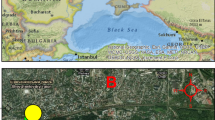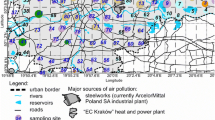Abstract
This investigation was carried out within the scope of EU-FP5 project MAGPROX. In parallel with the work of Kalinski et al. (2004, submitted), in which the magnetic signatures of the same soil profiles were analysed in more detail. The ‘hot spot’ under investigation was situated in the Lausitz area, Eastern Germany, between two major power plants, Schwarze Pumpe and Boxberg. This heavily industrialized region is known as the Black Triangle, named after the large lignite deposits and the old-technology power plants, among other petrochemical plants, refineries, textile manufacturing and glasswork industries. The relationship between magnetic parameters and heavy metal concentrations (Fe, Mn, Zn, Pb, Cu, Cr, Cd, Co and Ni) in soil profiles was determined statistically using linear regression analysis. Strong positive correlation was observed between heavy metal concentrations as viewed preliminarily from the heavy metal and magnetic susceptibility distributions with depth (soil profiles), and from the correlation coefficients obtained.









Similar content being viewed by others
References
Beckwith PR, Ellis JB, Revitt DM, Oldfield F (1986) Heavy metal and magnetic relationships for urban source sediments. Phys Earth Planet Int 42:67–75
Bundesamt für Umwelt, Wald und Landschaft (1989) Wegleitung für die Probenahme und Analyse von Schadstoffen im Boden, Blackwell Wissenschafts Verlag, p 15
Dedik AN, Hoffmann P, Ensling J (1992) Chemical characterization of iron in atmospheric aerosols. Atmos Environ 26A:2545–2548
Dekkers MJ, Pietersen HS (1992) Magnetic properties of low-Ca fly ash: a rapid tool for Fe-assessment and a survey for potentially hazardous elements. Mater Res Soc Symp Proc 245:37–47
Ďurža O (1999) Heavy metals contamination and magnetic susceptibility in soils around metallurgical plant. Phys Chem Earth A 24:541–543
Fiedler HJ, Rösler HJ (1988) Spurenelemente in der Umwelt. Ferdinand Enke Verlag, Stuttgart, p 255
Fisher GL, Chang DPY, Brummer M (1976) Fly ash collected from electrostatic precipitators: microcrystalline structures and the mystery of spheres. Science 7:553–555
Georgeaud VM, Rochette P, Ambrosi JP, Bottero JY (1997) Heavy metal sorption and magnetic properties of magnetite: a case study. In: Book of Abstracts, 8th scientific assembly of IAGA, 4–14 August 1997, Uppsala, Sweden
Hanesch M, Scholger R, Dekkers MJ (2001) The application of fuzzy C-means cluster analysis and non-linear mapping to a soil data set for the detection of polluted sites. Phys Chem Earth A 26:885–891
Hansen LD, Silbermann D, Fisher GL (1981) Crystalline components of stack-collected, size-fractioned coal fly ash. Environ Sci Technol 15:1057–1062
Hoffmann V, Knab M, Appel E (1999) Magnetic susceptibility mapping of roadside pollution. J Geochem Explor 66:313–326
Höper H (1998) The German Federal Soil Protection Act, BbodSchG, Geological Survey of Lower Saxony, Department of Soil Survey and Soil Research, Institute of Soil Technology, Bremen
Hunt A, Jones J, Oldfield F (1984) Magnetic measurements and heavy metals in atmospheric particulates of anthropogenic origin. Sci Tot Environ 33:129–139
Kalinski V, Rösler W, Hoffmann V, Appel E, MAGPROX Team (2004) Environmental hotspot screening/monitoring in Spremberg and Weißwasser Area, Germany; detailed surface/soil profile magnetics. Sci Tot Environ (submitted)
Knab M, Appel E, Hoffmann V (2001) Separation of the anthropogenic portion of heavy metal contents along a highway by means of magnetic susceptibility and fuzzy C-means cluster analysis. Eur J Environ Eng Geophys 6:125–140
Magiera T, Strzyszcz Z (1999) Ferrimagnetic minerals of anthropogenic origin in soils of some Polish national parks. Water, Air Soil Pollut 124:37–48
Petrovský E, Ellwood BB (1999) Magnetic monitoring of air-, land- and water pollution. In: Maher BA, Thompson R (eds) Quaternary climates, environments and magnetism. Cambridge University Press, Cambridge, pp 279–319
Petrovský E, Kapicka A, Jordanova N, Knab M, Hoffmann V (2000) Low-field magnetic susceptibility: a proxy method in estimating increased pollution of different environmental systems. Environ Geol 39:312–318
Petrovský E, Hulka Z, Kapicka A, MAGPROX Team (2004) New tool for in-situ measurements of vertical distribution of magnetic susceptibility in soils as basis for mapping deposited dusts. Environ Technol 25:1021–1029
Schibler L, Boyko T, Ferdyn M, Gajda B, Höll S, Jordonova N, Rösler W, MAGPROX team (2002) Topsoil magnetic susceptibility mapping: data reproducibility and compatibility, measurement strategy. Stud Geophys Geod 46:43–57
Strzyszcz Z, Magiera T (1993) Distribution of ferromagnetics in forest soils of some Polish and German regions in relation to their origin. Mitteilungen der Deutschen Bodenkundlichen Gesellschaft 72:1309–1312
Thompson R, Oldfield F (1986) Environmental magnetism. Allen and Unwin, London, p 227
Acknowledgements
This study was carried out as part of the MAGPROX EU FP5 RTD Project no. EVK2-CT-1999-00019. We would like to thank the Polish partners of the project at the Institute of Environmental Engineering in Zabrze, for their help for the chemical analysis.
Author information
Authors and Affiliations
Consortia
Corresponding author
Additional information
MAGPROX team–FP5 RTD Project No. EVK2-CT-1999-00019
Rights and permissions
About this article
Cite this article
Spiteri, C., Kalinski, V., Rösler, W. et al. Magnetic screening of a pollution hotspot in the Lausitz area, Eastern Germany: correlation analysis between magnetic proxies and heavy metal contamination in soils. Environ Geol 49, 1–9 (2005). https://doi.org/10.1007/s00254-005-1271-9
Received:
Accepted:
Published:
Issue Date:
DOI: https://doi.org/10.1007/s00254-005-1271-9




